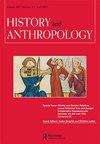海运集装箱
IF 0.4
2区 历史学
Q3 ANTHROPOLOGY
引用次数: 1
摘要
当“永远的给与”号巨轮被困在苏伊士运河中时,这艘巨轮的背上载着18300个长方形的钢箱。在事件发生后的几个星期和几个月里,被隐藏在集装箱里的物品——陷入法律困境——引起了全球的关注。在第二次世界大战后的几年里,技术得到了发展,标准化的航运集装箱已经成为国际贸易变革的主角之一。但容器的隐蔽性和交易性的逻辑也使得“盒子”在大众文化和社会理论中成为一个常见的形象。这篇文章通过关注工作中的集装箱来询问运输集装箱的多种功能。通过追踪集装箱如何通过港口基础设施移动,本文将我们从苏伊士运河带到另一个中央海上通道:直布罗陀海峡。本文反思了集装箱在港口中发挥作用的不同尺度:从沉重的物质性到抽象的代码和计量单位。本文章由计算机程序翻译,如有差异,请以英文原文为准。
The shipping container
ABSTRACT When the Ever Given became stuck in the Suez Canal, the megaship was carrying 18,300 rectangular, steel boxes on her back. In the weeks and months after the incident, the concealed contents of the shipping containers – stuck in legal limbo – captured global attention. Technologically developed in the years after the Second World War, the standardized shipping container has featured as one of the protagonists of the transformations in international trade. But the container’s logic of concealment and transaction has made ‘the box’ a common figure also in popular culture and social theory. This essay interrogates the shipping container’s multiple repertoires by focussing on containers at work. By tracing how the shipping container moves through the port infrastructure this essay takes us from the Suez Canal towards another central maritime passageway: the Strait of Gibraltar. This essay reflects on the different scales at which the shipping container functions in the port: from heavy materiality to abstracted codes and units of measurement.
求助全文
通过发布文献求助,成功后即可免费获取论文全文。
去求助
来源期刊

History and Anthropology
Multiple-
CiteScore
1.80
自引率
0.00%
发文量
41
期刊介绍:
History and Anthropology continues to address the intersection of history and social sciences, focusing on the interchange between anthropologically-informed history, historically-informed anthropology and the history of ethnographic and anthropological representation. It is now widely perceived that the formerly dominant ahistorical perspectives within anthropology severely restricted interpretation and analysis. Much recent work has therefore been concerned with social change and colonial history and the traditional problems such as symbolism, have been rethought in historical terms. History and Anthropology publishes articles which develop these concerns, and is particularly interested in linking new substantive analyses with critical perspectives on anthropological discourse.
 求助内容:
求助内容: 应助结果提醒方式:
应助结果提醒方式:


